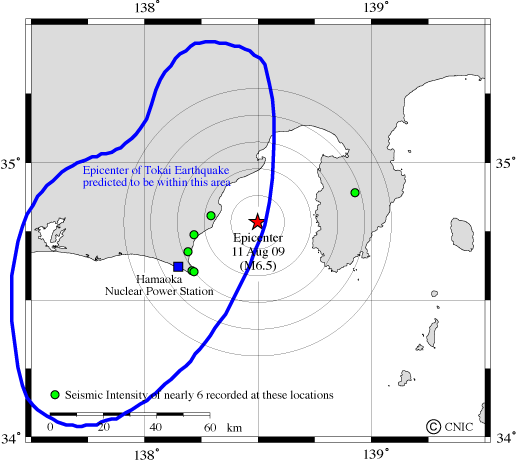Hamaoka Nuclear Power Station Struck By Earthquake
Chubu Electric Power Company's Hamaoka Nuclear Power Station was struck by a magnitude 6.5 earthquake at 5:07am on August 11. The epicenter was 37 kilometers from the Hamaoka plant in Suruga Bay, in Shizuoka Prefecture (see map). The depth of the earthquake source was 23km. By comparison, the epicenter of the M6.8 Chuetsu-oki Earthquake, which struck the Kashiwazaki-Kariwa Nuclear Power Station (KK) in July 2007, was 10km from the plant and the depth of the source was 10km.
Hamaoka-4 and -5 shut down automatically. At the time, adjustment operations were being carried out at Hamaoka-4, which was in the final stages of scheduled maintenance. Unit 5 had just completed scheduled maintenance two weeks earlier, while Unit 3 was still shut for scheduled maintenance. Units 1 and 2 were shutdown permanently in January this year (see NIT 128).
The maximum ground motion recorded at the base plate of each plant was as follows.
| Plant |
Unit 1
(BWR, 540 MW) |
Unit 2
(BWR, 840 MW) |
Unit 3
(BWR, 1,100 MW) |
Unit 4
(BWR, 1,137 MW) |
Unit 5
(ABWR, 1,380 MW) |
| Ground Motion |
109 Gal |
109 Gal |
147 Gal |
163 Gal |
426 Gal
|
(Gal is a measure of acceleration. 1 gal = 0.01 m/s2.)
The extraordinarily large ground motion recorded at Unit 5 was less than the 600 Gal "Extreme Design Earthquake" (S2) for the plant under the old seismic guidelines, or the 800 Gal "Design Basis Earthquake Ground Motion" (Ss) under the revised guidelines. However, the spectrograph readings submitted by Chubu Electric to the Nuclear Industrial and Safety Agency (NISA) showed that in the natural period range (0.35 - 0.45 second) the spectrograph recorded on the second floor basement of Unit 5 exceeded the "Maximum Design Earthquake" (S1) under the old seismic guidelines. Surprisingly, the ground motion at the base plate of Hamaoka Unit 5 was larger than that the 322 Gal recorded at KK-6 and the 356 Gal at KK-7 (both ABWR, 1,356 MW) during the Chuetsu-oki earthquake, despite the fact that the latter earthquake was larger and the epicenter was much closer.
Release of Radioactivity
On the day of the earthquake a radiation monitor in the fuel exchange area within the Unit 5 reactor building indicated that the radioactivity level was eight times higher than normal. The radioactivity concentration in the fuel pool water was measured at 10 Bq/cm3, which is fifty times the normal level of 0.2 Bq/cm3. Elevated radioactivity was also recorded in the fuel coolant purification pump room in the reactor building of Unit 2.
Chubu Electric initially said that no radiation was released. However, a release of radioactive iodine-131 (300,000 Bq) from Unit 5 was detected on August 19. According to Chubu Electric, the radioactivity was noticed during the weekly replacement of an exhaust gas filter in the reactor. It claimed that the radioactivity concentration was three times higher than cautionary levels but lower than legally allowable levels.
Damage
Chubu Electric said that initial visual inspections revealed no damage, but in subsequent reports it acknowledged that the earthquake had caused damage to the plants. An August 18 report identified a total of 46 problems, 25 of which related to Unit 5. Damage to Unit 5 included cracks in the walls of the turbine building, damage to the motor control unit of a control rod drive mechanism, malfunction of the start-up range neutron monitor, incorrect measurement by a reactor feedwater flow meter and damage to a weld in an air conditioning duct in the containment cask. Damage to other units included subsidence and upheaval of the ground around the cooling water intake area for Unit 1 and malfunction of the start-up range neutron monitor in Unit 4.
Comments
This earthquake gives rise to serious questions about the safety of the Hamaoka Nuclear Power Station. The fact that an earthquake that arose so far away could cause so large a ground motion begs the question of whether the plant could withstand an earthquake immediately beneath the plant. It is predicted that the Tokai Earthquake will be in the order of M8.4 - M8.5. Such a quake will release 700 - 1,000 times as much energy as the August 11 quake. Furthermore, it could strike directly beneath the Hamaoka Nuclear Power Station. Chubu Electric claims that the Hamaoka units have been strengthened to withstand a ground motion of 1,000 Gal, but the evidence from the recent earthquake suggests that this is far from sufficient.
It is likely that Unit 5 will be shut down for several months, but Chubu Electric is hoping to restart Units 3 and 4 soon. One wonders what it will take for the government and the nuclear power companies to learn their lesson. It seems that nothing less than a full-scale nuclear-earthquake disaster will suffice.
Philip White and Chihiro Kamisawa (CNIC)

Return to NIT 132 contents

